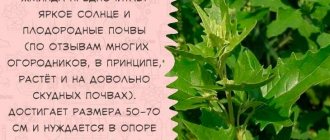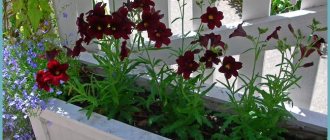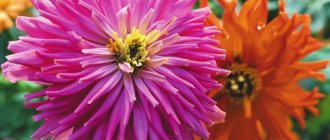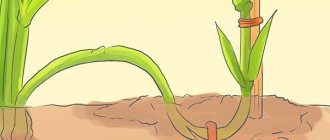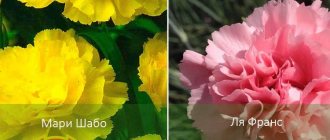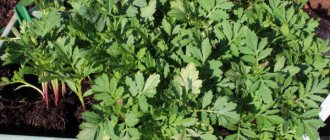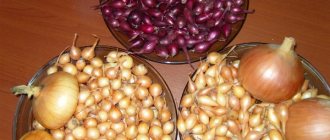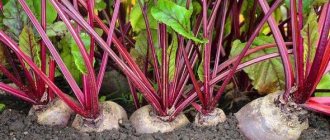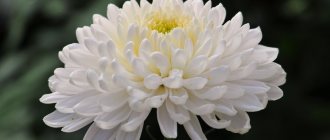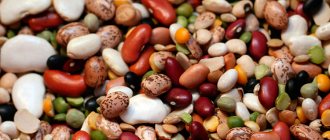Peculiarities
Balsams have jagged or oval leaves in a wide variety of green shades. The fruit consists of a multi-seeded capsule. If you touch it with your hand, it will instantly open and the seeds will fall out.
Impatiens have a wide palette of colors. There are representatives with bright red, purple-pink flowers, monochromatic or multi-colored. For example, double and semi-double flowers reproduce the shape of a camellia, carnation or rose. In addition, in one group you can find buds with different degrees of development: blossomed, unblown and withered. Hybrids of carmine, red and purple-pink shades are widespread.
The plant grows well in moist, fertile soils. Initially, balsam was popular in tropical Africa, India, China, and then it spread throughout the Northern Hemisphere.
Varieties
Thanks to the intensive work of breeders, many varieties and hybrids of ampelous balsam have appeared, which differ in size, color of leaves and flowers.
Among the most common varieties are the following.
Name
Description Tumbler White Flowers bloom with a diameter of 4-5 cm, their color is white. Atena Coral Pink Double inflorescences are scarlet in color, their diameter is the same as that of the previous variety. Scarlet The flowers are painted red and are 4-5 cm in diameter. Atena Red Flash The color of numerous colors is red with white splashes. Tumbler Rose Bush is decorated with pink flowers. Violet Star Dark pink inflorescences have white stripes that extend from the center of the flower and continue to the middle of the petal. Wallera Athena Appleblossom The diameter of the flowers is from 4 to 5 cm, the outer side of the petals is white, and the inner side is painted pink. Tumbler Salmon Flowers are salmon-colored, their diameter is from 2.5 to 3.5 cm.
Chandelier balsam: description
This plant has an interesting nickname - Vanka wet. It was so nicknamed due to the fact that small drops of liquid are released along the edges of the leaves. In another way it is called “light”. The brightly colored flowers glow against the green leaves. Plants of this species are perennials, they are very branched and have a thick stem. Green or red-brown leaves are small, oval in shape. White, red or pink flowers are located at the ends of the branches.
If you follow the rules of care and planting, ampelous balsam at home can bloom throughout the whole year, and in the summer you can decorate terraces and flower beds with it. Impatiens do not like bright daytime sun; they prefer light partial shade. In diffused light, the flowers become brighter in color. Supports or wings protect the delicate plant from winds and rain.
Description
The genus Impatiens includes over 500 species of annual and perennial herbaceous plants of the balsam family. Its homeland is the tropics and subtropics of Asia and Africa; some species are found in Central Asia.
Impatiens as a houseplant have been known for a very long time and are always popular. This is probably the most popular plant in the world. The first balsams were brought to Europe in 1596. Thanks to its unpretentiousness, year-round flowering and ease of propagation, this cute plant has been loved for more than four hundred years. Many of its popular names are known: touch-me-not, light, Vanka - wet, evergreen.
The stems of balsams are succulent, branched, and vary in height from 15 to 50 cm in different varieties. The leaves are green, reddish-green or bronze, wavy at the edges, fleshy. When humidity increases, droplets of liquid appear at the tips of the leaves, for which the plant is called Vanka - wet.
Balsam flowers are located in the axils of the leaves. They come in white, pink, orange, red, purple, and also with stripes or spots. Hybrids with double flowers and multi-colored leaves have been bred. The flowers are small, but very bright, reminiscent of lights, hence the name “light”.
After flowering, balsam produces green fruits, which, after ripening, form a dry capsule with seeds. Even with a light touch it “explodes” and scatters seeds. The popular name “touch-me-not” apparently took root precisely because of this feature of the plant.
It’s also not for nothing that balsam is called the everlasting flower - balsams bloom very profusely almost all year round.
Impatiens are grown as an annual plant for balconies and gardens, and also as a perennial unpretentious house plant.
Intensive breeding work has made it possible to develop many hybrids and varieties of balsams, differing in height, flower color and size, and leaf color.
Balsam Fiesta Pink Ruffles Balsam Dezire Starburst Rose
There are varieties for flower beds that can withstand low temperatures. They decorate balconies and flower beds from early spring until almost frost.
Balsam is suitable for landscaping a children's room; it can often be seen on the windows of schools and kindergartens.
Among the balsams, the species are especially decorative: Waller's balsam, or Wallera (Impatiens walleriana) - the ancestor of a huge number of modern hybrids, a profusely flowering plant with reddish-brown leaves and succulent stems. There are so many flowers that they can almost completely cover the leaves; Hawker's balsam (Impatiens Hawkeri) - from it came New Guinea balsam hybrids (Impatiens New Guinea) with elongated leaves and large flowers that bloom throughout the year. These hybrids grow well in the sun.; Niamey balsam (Impatiens niamniamensis) with stunning red, yellow or bicolor bean-shaped flowers.
Impatiens Hawkeri Impatiens Niamniamensis
Varieties
Terry ampelous balsam has many shaggy flowers. The chic shape of this variety is used for hanging baskets. This is a very branching plant, strewn with flowers with shoots of 30–35 cm. It blooms from June until frost. The plant is grown in places with diffuse sunlight or partial shade.
Balsam ampelous Acrobat is characterized by rapid growth. One flower is enough to create a luxurious hanging basket. It has a huge number of constantly updated colors. Tolerates rainy weather well. Impatiens are best grown in partial shade. Blooms from June to November.
Impatiens propagation methods
How to plant and grow walnuts correctly
Impatiens is propagated using seeds extracted from berries or by cuttings. The berries contain a whole nursery of small grains that can sprout for six years. Sowing planning begins in January in order to achieve seedlings flowering in May.
Before sowing, the seeds are immersed in a weakly concentrated solution of potassium permanganate, and then soaked for a day in clean water. Plant the seeds in a substrate containing peat and sand. The seed material is lightly sprinkled with soil and covered with polyethylene. Store containers with seedlings in a warm place. Every day, the seedlings are taken out into the fresh air and the soil is sprayed. The germination process usually takes from 1.5 to 2 weeks.
As soon as the sprouts acquire a pair of true leaves, they begin picking and plant the seedlings in different pots. A plant intended for landscaping a room is immediately placed in a permanent container. Outdoor seedlings are transferred to peat pots so that after a while the bushes are removed and planted in open ground. After the formation of 6-8 leaves, the crown is pinched, then the stems will branch better.
The vegetative method involves cutting apical cuttings approximately 6 cm long. The lower leafy tier is cut off, and only half of the foliage is left on top. The branches are dipped into water so that the first roots appear. After some time, the cuttings begin to take root and produce inflorescences after 2-3 months.
Balsams in the natural environment
There are many different species in nature, for example, subshrubs, herbaceous annuals and perennials. Some species grow up to two meters in height. All of them, without exception, are united in one family - balsam.
Reproduction of balsam in nature occurs naturally. In culture - from seeds. Ampelous balsams can also be propagated from cuttings. The island of Zanzibar is considered the birthplace of this tropical plant. Back in 1596, balsam was brought to Europe, where it quickly gained popularity. The first cultivated species were bred there. There are three of them: garden balsam, New Guinea and Wallera.
Description of impatiens
Straight, succulent stems emerge from the branched rhizome, which over time begin to actively branch and weave into a spherical bush. The height of the bush is no more than half a meter. If a humid climate prevails, small droplets, like sugar grains, accumulate on the surface of the shoots.
Oval or ovoid foliage is supported on the stems by shortened petiolar processes. The size of one leaf does not exceed 12 cm. The edges of the foliage are jagged, and the central part of the plate is decorated with a convex network of veins. The color of the leaves is uniform. Green, bronze and purple varieties are common.
Flowers located in the axils are formed in late spring. Throughout the summer and autumn, fresh inflorescences replace wilted buds. The petals are red, lilac, violet or blue. Varieties have been bred that have 5 protruding petals in the bell cup. Among the cultivated species there are also velvety specimens. Their buds look like small roses.
After wilting, the flower gives rise to a berry ovary. Berries are very sensitive to any touch. When the branches shake, the fruits begin to open and spill the seeds.
New Guinea balsam
This species originates from Hawker's balsam, for this reason they are in some cases called "Hawker's balsams." Blooms mainly in summer. The flowers are large and come in a variety of colors. Leaves and shoots are burgundy or purple. In flower shops you can find more than 80 varieties. The first hybrid was developed in the USA in 1972. They are grown at home or as an annual plant in the garden. Plants of this species prefer warmth, tolerate the sun well and are not afraid of low indoor humidity; they are more hardy than other species.
The most popular indoor varieties of balsams
Several decorative types of balsam are often grown at home:
Waller's balsam (Willer ). Perennial with regular or double flowers of various colors. Stems are oblong. Above the green mass there are many bright buds.
Peters' balsam . It differs from the first one in its larger size and bronze color of the stems and leaves. The flowers are a rich red hue; lilac and pink varieties are less common.
New Guinea balsam . It has a stronger stem, fleshy leaves and large flowers (5–8 cm). The bush itself is very compact, which is appreciated in home floriculture. The hybrid is hardy, blooms continuously and has different petal colors.
Balsam tom tumb . A strongly branched dwarf plant up to 25 cm high. The flowers are bright and double. In open ground it blooms from June until frost. Perfect for home growing.
Impatiens is the very case when you can grow a beautiful plant without special knowledge of gardening. A little attention, care and love, and the green pet will thank the owner with bright, lush and long-lasting flowering.
Propagation from seeds
Chandelier balsam is picky about its conditions, so it is best to grow it by gardeners who have accumulated sufficient experience.
Balsam cultivation begins with planting seeds. The soil should contain peat, sand, vermiculite and compost. Before planting seeds, treat the pot and soil with a fungicidal agent to prevent the spread of fungal diseases. In addition, it is recommended to pickle the seeds in a weak solution of potassium permanganate - about ten minutes, then wash them with clean warm water.
Planting rules:
- the seeds are laid out on the surface of the soil;
- press them into the ground with light pressure;
- covered with sand;
- cover the container with seeds with plastic wrap;
- The container with the seeds is transferred to a warm, well-lit place.
Seeds germinate at temperatures from +22 to +25 °C. As soon as the first sprouts appear, the temperature is lowered to +20 °C and the film is removed. Impatiens should not be placed in direct sunlight, as this plant has very delicate seeds that do not tolerate ultraviolet radiation. As soon as the first three leaves appear, the plant is picked. It is recommended to replant the plant in the garden in early spring (one hundred days after planting the seeds in the pot). Ampelous balsams, reviews of which are mainly devoted to growing at home from seeds, come down to the following:
- when planting, avoid drafts;
- the first shoots appear after about three weeks;
- It is better to plant seeds at a large distance from each other so that when picking, the roots can be easily separated;
- an adult plant with dense branches and all dotted with beautiful flowers;
- flowers look beautiful in a hanging pot.
Growing balsam from seeds is not easy, but if you follow all the requirements, you will end up with a healthy and long-flowering plant that can decorate any room.
Landing Features
It is recommended to plant seeds for seedlings in mid-March. However, seeds for growing ampelous balsams will have to be purchased even earlier, because... Before sowing, it is better to soak them for a day in a solution of potassium permanganate for disinfection, and then rinse with warm water. After 100 days, the seedlings can either be planted in the ground or planted in pots for further cultivation at home.
Purchased balsam seeds are like a lottery; they may sprout or they may not. Therefore, one pack will not be enough.
The ideal soil for ampel balsam is a mixture of peat, sand, vermiculite (mineral) and compost (or leaf soil). Sand is needed here for greater looseness.
Prepare containers for planting. Distribute the seeds over the surface of the soil. They just need to be laid out on top, pressing down lightly, and you can sprinkle a thin layer of sand on top. Lightly moisten the soil and cover the container itself with film or glass to retain heat.
For a container with seeds, find a place in the house where it is warm and has enough sunlight. Direct rays of the sun are dangerous for balsam, but it does not feel well without any sun at all. So look for which corner of your home has a lot of indirect sunlight.
Remove glass (or film) periodically (ventilate). Make sure the soil does not dry out. When three leaves appear, a dive is performed.
If you are planting in pots
, then don't buy too big. Oddly enough, balsam is more comfortable when it’s cramped.
After transplanting, you will have to water every day, but make sure that moisture does not stagnate. Those. You don’t just need to go up and water, but first assess the condition of the soil. Maybe there is still enough moisture.
It is advisable to water with settled water at room temperature.
In addition to regular watering, rich flowering will require weekly feeding
. Crystalon brown has proven itself well in this matter. To prepare complex fertilizer, 1 tbsp of powder must be dissolved in 5 liters of water. Water the balsam with the resulting solution 1 or 2 times a week.
Chandelier balsam: care
Impatiens are usually grown in small pots. If the container is too large, the plant will not bloom.
The plant must be fed every seven days. The fertilizing should contain copper, iron, boron, zinc, molybdenum and manganese. Water the balsam every day, but not too much. Waller's balsam does not tolerate stagnant water. Unlike seeds, a mature plant needs sunlight. If there are at least six hours of sun during the day, the plant will bloom a lot and for a long time.
As soon as the balsam has bloomed, it should be trimmed and moved to a cool place with a temperature no higher than +15 °C, and the frequency of watering should be reduced. New shoots, as a rule, appear towards the end of winter, at which time the balsam needs to be moved to a warm room and watering increased.
In winter, the flower should be placed in a bright, cool room and watered moderately. If the temperature drops below +15 °C, black spots may appear on the shoots - bacteriosis. In this case, you should water the plant with a solution of phytosporin or tetracycline antibacterial agents - 1 tablet or capsule per glass of water. The next way to save a plant is to cut off healthy shoots. Acidic soil also causes the development of this disease. Dark-colored varieties are more durable than light-colored flowers.
Planting balsam seedlings in open ground
The optimal time for planting balsam in open ground is May, when the threat of return spring frosts has passed.
Impatiens require moderate sun (the plant does not tolerate strong sunlight and begins to wither) and good protection from the winds. Therefore, the ideal place for planting it would be a bed near a fence or a flower bed near sparse trees.
Garden balsam grows well in soft and loose soils that are well drained and never acidic.
Advice! You can successfully grow balsam in a flower pot or in a balcony box.
Before planting the plant, it is advisable to treat the soil with a special fungicide, and also add manure (not fresh!) and water it. You can also use vermicompost as a top dressing.
Now you need to remove the balsam seedlings from the containers along with a lump of earth and carefully place them in the hole, sprinkle them with soil and press them in a little. It will not be superfluous to mulch the planting with sawdust (or any other mulch) so that the soil around it does not dry out and you do not have to water it endlessly. In addition, this is an additional plus for the plant, since the root collar is mulched and thus the roots of the plant will not be washed away during watering.
The planting scheme for balsam is at a distance of 25-30 cm from each other, because The flowers grow very luxuriantly.
Sowing seeds directly into open ground
If the air temperature rises to 20-25 degrees (and this is the end of May-beginning of June), then balsam seeds can be sown immediately in open ground. However, if the night air temperature drops below 19, then young crops will need to be covered with cellophane, or even better with spunbond or acrylic (depending on what you have), thereby creating a greenhouse effect.
Content problems
Chandelier balsam, the cultivation of which we are discussing today, can cause some difficulties if not properly cared for:
- Lack of light in the room - the flowers turn pale.
- A sharp cold snap, dry or cold air, low humidity, dry soil - flowering stops, flowers and buds fall off.
- A cramped pot, lack of nutrients in the soil - plant growth slows down.
- Low air temperature, insufficient watering - drooping leaves.
- Insufficient lighting, cold air, waterlogged soil - the roots and base of the stems rot.
How to care for indoor impatiens flower
Location.
Once upon a time, balsam could be found in almost every apartment. Adults loved it for its beauty during flowering and ease of care, and children feasted on the petals of pink and white flowers with a pleasant, sour taste. It is not difficult to provide decent conditions for growing balsam, because it is truly a very unpretentious plant. It feels great not only in the room, but also outdoors. Therefore, in summer you can easily transport it to the garden plot or take it out to the balcony.
Impatiens grow well on any, even northern windows; they only need shading from direct, hot sunlight on southern windows. At high temperatures and lack of light, plants shed their leaves.
After gradual hardening, the light-loving Sultan's balsam can be placed in open places, and the shade-tolerant Waller's balsam can be placed in places protected from the sun. The plant should be removed from open ground long before the night frosts.
The soil. It is better to plant them in pots commensurate with the root system, filled with a loose nutritious soil mixture of leaf soil, greenhouse soil and sand (4: 2: 1).
Impatiens like to grow in small containers, so when replanting them in the spring, choose a flower pot that is only slightly larger in size than the balsam's root system.
Feeding. When caring for balsam flowers at home, fertilizing with complete mineral fertilizer should be done at least twice a month. In summer, they should be watered abundantly and fed every 10–15 days with mullein (1:10) or a 2% solution of complete mineral fertilizer.
Watering. During the growing season, growing and caring for balsam requires regular watering, especially during dry periods. In winter, keep at a temperature of 14–16 °C, water less often, without flooding, since balsams do not stop growing during this period.
How to care for indoor balsam flowers, which are New Guinea hybrids? They should definitely be pinched. Frequent loosening of the soil and weeding are necessary.
If your plant drops yellowed lower leaves and does not bloom, it means it is not getting enough light. Move it to a brighter place.
If a plant's leaves fall off in winter, it means your plant is cold—put it in a warmer place.
If the root collar of the plant becomes covered with black spots, pay attention to watering. You're probably over-watering the soil
Stop watering the plant until the soil dries out.
The main pests when growing balsam flowers are aphids, spider mites, feltworms and nematodes.
Diseases and pests
In winter, balsam is susceptible to fungal diseases, especially gray rot. To eliminate this problem, the roots of the plant are cleaned from the old soil and the balsam is transplanted into a new container with soil.
If there is little humidity in the room, the plant is attacked by spider mites. The initial sign is curled leaves that fall off over time. To combat spider mites, special means are used.
When infested with whitefly, the leaves turn yellow. As a rule, it settles on the inside of the lower leaves. The following drugs are used to treat the plant: “Fufanon”, “Decis” and others.
Caring for an adult plant
New Guinea balsam - growing at home and in the garden
To get a beautiful balsam bush and lush flowers on it, every gardener needs to know how to care for it.
Creating comfortable conditions is the key to lush, year-round flowering
The flower is provided with proper watering. It should be moderate, but sufficient. It is best to focus on the condition of the soil in the frequency of moistening - it should not dry out completely.
In winter, the frequency of soil moisture is reduced.
Attention! After watering, the accumulated water in the pan is poured out. Stagnation of liquid can cause root rot.
Fertilizers, plant nutrition
Feeding is necessary during the period of active flower growth, April–August. Complex mineral fertilizers are suitable.
When choosing a suitable fertilizer, carefully read its composition; it should not contain a high nitrogen content. A large amount of nitrogen leads to active growth of greenery, inhibiting the appearance of inflorescences.
A good fertilizer contains the following components:
- iron;
- magnesium;
- nitrogen;
- copper;
- molybdenum;
- phosphorus;
- manganese;
- zinc;
- boron
For lush flowering, it is recommended to feed with the drug Kristalon - 1 tbsp. l. for 5 liters of water, apply once a week.
Common diseases and pests
Impatiens are vulnerable to diseases during the cold season. Due to improper watering, a fungus - gray rot - may appear on the flower. This is a most dangerous disease, the treatment of which involves removing the damaged parts and replanting the bush in new soil.
Leaves are the first to respond to diseases
Among the pests, the flower can be attacked by spider mites. Signs are the appearance of small white dots and thin threads of cobwebs on the foliage, and the leaves curling inward. To combat ticks, the drugs Neoron and Actellik are used.
Whitefly is another insect that can cause damage to leaves and inflorescences. Signs: rapid yellowing of leaves. Treatment is carried out with Decis or Fufanon.
Impatiens is a bright, delicate flower, beautiful for its decorative properties. It is planted on balconies and in gazebos, in flower beds in open ground. Keeping balsam cannot be called easy, but all the work is worth it to admire the constant, lush color of the rich palette of petals all year round.
Beneficial features
A decoction of fresh balsam leaves is used as an adjuvant for stones in the bladder and kidneys. A decoction added to the bath will relieve pain in rheumatological diseases. To treat wounds, ulcers and hemorrhoids, applications are made from the leaves. A tincture of roots, flowers and seeds helps with fatigue and relieves headaches.
However, we must remember that balsam is toxic and its chemical composition has not been sufficiently studied, for this reason therapy should be carried out very carefully. In case of overdose, the following symptoms appear:
- dizziness;
- vomit.
Description of the flower
Impatiens is a herbaceous plant with fleshy, erect stems. The plant is nourished by a branched rhizome. The shoots actively branch and form a spherical bush up to 50 cm high. At high humidity, small granules similar to grains of sugar form on the stems.
The leaves are attached to the stems on short petioles and are oval or ovoid in shape. The length of each leaf is 8-12 cm. The edges of the soft leaf plate are covered with small teeth, and the surface has a relief pattern of veins. The leaves are a solid green color, but sometimes have bronze or purple hues.
Single axillary flowers begin to appear in May and replace each other until December. The color of the petals can be red, pink, lilac, violet, blue, lilac, yellow. There are varieties with simple 5-petaled flowers in the form of an open bell. Today you can find velvety forms of plants whose flowers resemble a small rose.
A small berry is tied in place of the flower. She is very sensitive to touch. At the slightest vibration, the berries open and numerous seeds spill out.
Interesting Facts
There is an opinion that the color of balsam buds can influence a person with its energy flows:
- orange – awakens sexuality;
- red – increases physical activity;
- purple – stimulates mental abilities;
- white – generates spirituality;
- pink – evokes emotion.
Appearance and features
This herbaceous plant can be grown as an annual or perennial. Belongs to the balsam family. The stems of the plant are succulent and branched. Their height is 15-50 cm. The leaves are green, reddish-green, and wavy at the edges. With high humidity, droplets of liquid form at the tips.
The flowers of the crop are located in the axils of the leaves; their color can be:
- white;
- pink;
- orange;
- red;
- lilac;
- with stripes and spots.
Hybrids with double flowers and multi-colored leaves were obtained. The size of the flowers is 6-8 cm. Despite their small size, they are very bright, like lights.
At the end of flowering, balsam produces green fruits. After ripening, they form a dry box with changes. Sometimes it is enough to lightly touch it, and the seeds simply scatter to the sides. Because of this feature, the plant is popularly called “touch-me-not.” It is not for nothing that the culture is called an ever-flowering plant, since flowering is abundant and is observed almost throughout the year .

